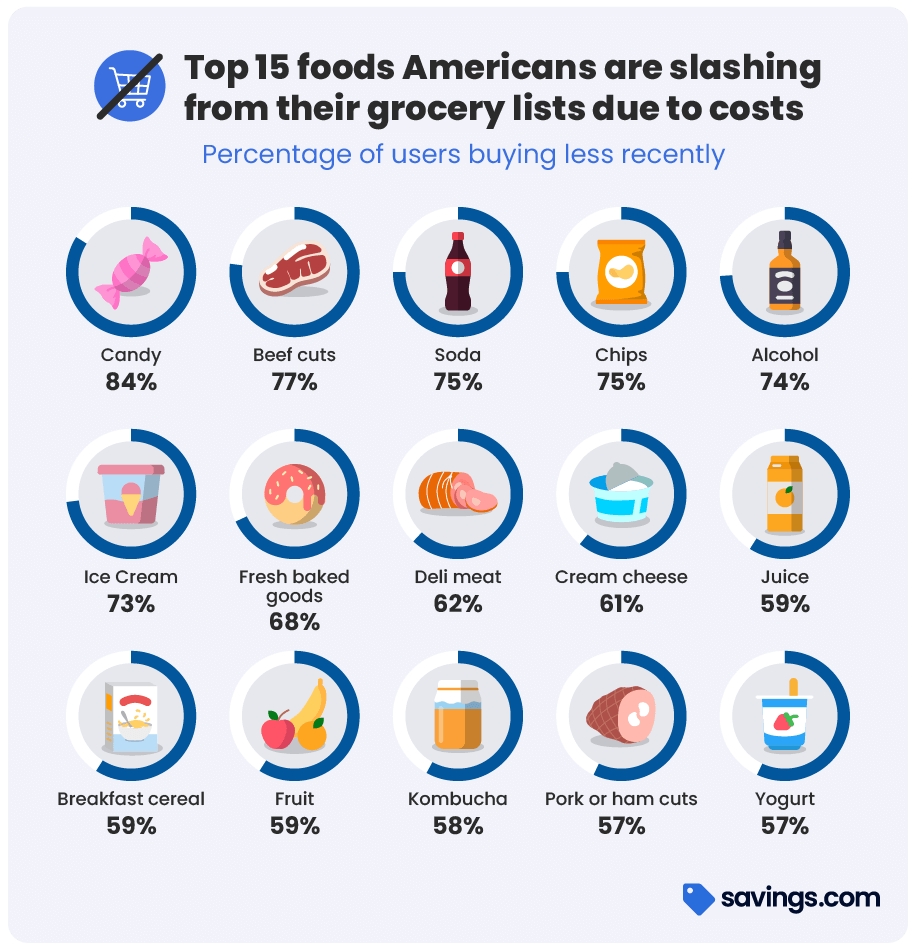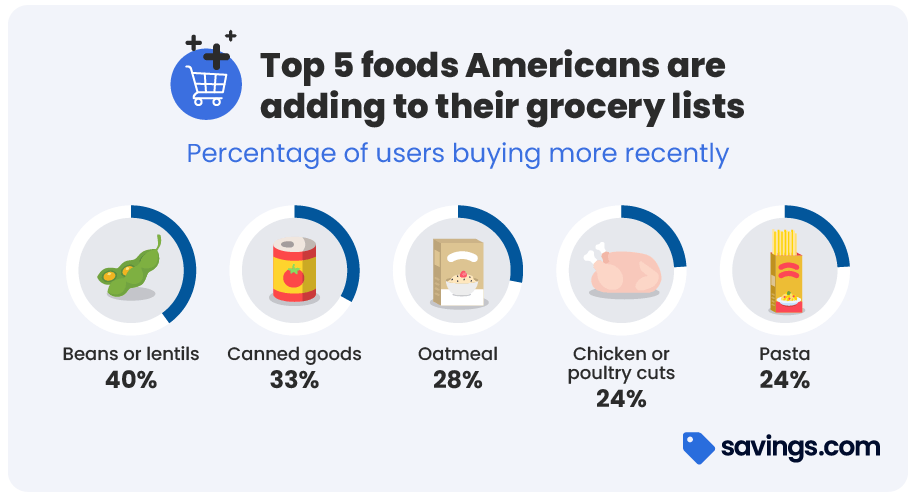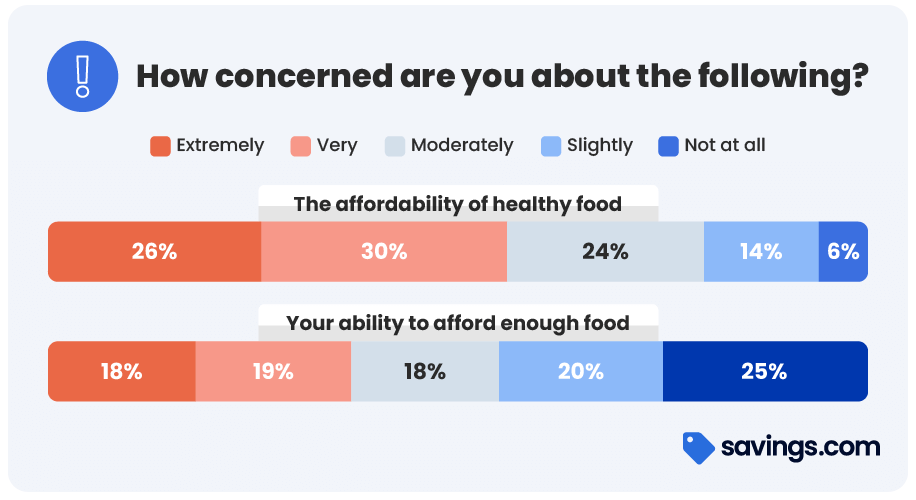
Last Updated: July 24, 2024
More than 1 in 3 Americans are very concerned about their ability to afford enough food; many have already reduced spending on candy, beef, alcohol, and more.
While inflation has cooled from its highs in 2022, many Americans still experience sticker shock regularly: it happens when they get their prescriptions filled, renew their car insurance, or pay the rent.
The shock doesn’t stop when they reach the grocery store. Since the early days of the pandemic, Americans have had to adjust to surging food prices, and for many people, those changes may well become permanent habits. According to USDA data, food costs are expected to rise again by just over two percent this year.
To understand how people are coping with rising grocery bills, Savings.com researchers conducted a study of nearly 1,000 adults about their current shopping and savings strategies. Here are a few of our key findings:
- 78 percent of U.S. adults have cut back on grocery purchases because of rising prices. Women and young adults were likelier than men and older people to make cuts.
- The typical household spends about $580 on groceries monthly. Due to soaring prices, Americans have been cutting back on candy, beef, soda, chips, and alcohol more than other grocery items.
- 37% of Americans are extremely or very concerned about their ability to afford enough food, and even more people are worried about the affordability of healthy foods.
- 56% of adults say they’ve chosen to buy generic or store-brand products more often in recent months because they are more affordable than name-brand goods.
- About 1 in 4 people who buy period products say they’ve had to buy fewer or lower-quality products due to rising prices.
Nearly 80 percent of U.S. adults have cut back on groceries
According to the USDA, food price surges peaked in 2022, rising by about 10 percent, the fastest since 1979. Supermarket food inflation was even higher than restaurant food inflation (11 percent vs. eight percent). Inflation continued in 2023, though it was slower, and 2024 is expected to see another downshift in food price inflation.
Of course, Americans haven’t had to spend more money on food alone in the past few years, as inflation has made everything from clothing to cars more expensive. But while a new ride or pair of sneakers is something most people can put off, there’s a necessity we humans can’t do without: food. We all need food to fuel our bodies and maintain optimal physical and mental health, making food a necessary purchase. And our research shows that the median household grocery spending is about $580 a month!
To compensate for rising supermarket prices, most people we talked to are tightening their belts—in more ways than one: 78 percent of the people we surveyed said they’ve cut back on at least one type of grocery item because of recent rising costs.

Women and younger adults were more likely to say they’ve cut back, while parents (both women and men) are more likely to have cut back on more grocery categories than men and those without kids.
Our research shows people’s food-buying habits have changed thanks to inflation and rising grocery costs. But that doesn’t always mean cutting back; for many people, it means shifting where they spend money. For an individual household, that could mean spending less on luxuries like sweets and alcohol and more on nutrient-dense, low-cost foods like beans and lentils.
These figures also mean people are shifting their habits and the types of food they eat. For example, 77 percent of people who eat beef told us they’re buying less beef, while nearly one in four are buying more chicken or other types of poultry, meaning people may be looking to get their protein from cheaper sources. According to BLS data, while a pound of ground beef costs nearly $5 on average, whole chickens are about half the cost per pound.
Foods like soda, chips, and ice cream are also frequently getting the ax, as is alcohol. But, as we mentioned, dense foods like beans and items that can be stockpiled, such as canned goods and pasta, are becoming more popular. To see a complete breakdown of how shopping habits have changed for a variety of goods, jump to our data appendix.

Of course, food is not the only product we purchase at the grocery store. About one-quarter of people who buy period products say they’ve had to change how they shop for these items, such as buying fewer products, choosing items of lower quality, or opting to buy reusable period products.
Most Americans are concerned about their ability to afford food
Only 25 percent of people said they aren’t at all concerned about their ability to afford food. At the same time, more than one-third are “very concerned" or “extremely concerned," which likely speaks to the blazing pace of price increases and the extended length of time we’ve all been coping with these rising costs.

Even more disturbing is the fact that affordability is more of a concern for healthy, nutritious foods, which can be more expensive. For example, the costs associated with transporting a truckload of canned goods are dramatically different from transporting fresh meat or produce that needs to be refrigerated throughout its journey. All these costs are passed onto consumers, who may be forced to choose a less-fresh option for financial reasons.
Fourteen ways people are creatively confronting rising grocery costs
Most people (83 percent) said rising costs have changed how they shop for groceries. Despite this widespread change, Americans are staying positive and doing all they can to make ends meet and provide nutritious meals for themselves and their families.
According to our analysis of open-text responses, these are the most popular grocery cost-saving methods Americans are using now to lower their grocery bills.
1. Clipping coupons
A significant number of respondents cited coupon use as a top method of saving money. Whether they find coupons in apps or clip physical coupons from newspapers, this remains the most popular way to save money (other than buying fewer items). People also told us they watch out for store-specific coupons and promotional codes. Major grocery retailers, like Vons, Kroger, and Safeway, offer hundreds of dollars in coupons each week.
2. Buying in bulk
Many shoppers told us they buy large quantities of items so they can take advantage of bulk pricing. That could mean filling their freezers with non-perishables like meat or stocking up on cans or other shelf-stable items. And they most often do this at warehouse clubs like Costco, BJs, or Sam’s Club.
3. Shopping store brands
Shoppers aren’t shy about experimenting not only with the types of foods they’re buying but in the brands they turn to. Generic or store brands, which tend to be cheaper, are becoming more popular. In fact, 56 percent of people told us they’re buying more generic or store brands than they were even just six months ago, as shoppers seem to see the quality levels as similar between name brands and generics.
4. Shopping sales and discounts
Respondents frequently mentioned looking for sales, promotions and weekly deals, with many people altering their intended purchases depending on in-store ads and flyers. People even said they plan their shopping trips around sales and special discount dates or purchase perishable items closer to their sell-by dates to save money.
5. Signing up for rewards and loyalty programs
Shoppers also take advantage of in-store loyalty cards and rewards programs, especially those that offer points, cash back, or discounts on future purchases. The widespread availability of such programs makes them an obvious tool for most people, as stores like Kroger, Fry’s, and Safeway all have their own programs, with some offering discounts on things like gasoline as well.
6. Meal planning
Many people also told us they’re taking a page from home ec, as they make it a point to plan meals in advance, creating a shopping list based on the ingredients they’ll need for the meals they plan to cook that week. This helps reduce impulse buying but also can cut down on food waste, as people can ensure they’re using the food they buy more efficiently. (An estimated 38 percent of all food in the U.S. goes uneaten or unsold.)
7. Shopping at discount stores
Shoppers’ habit changes go beyond buying new brands or trying new foods. Many people told us they’re turning to lower-cost grocery stores like Aldi, Lidl, and Walmart, where lower pricing on most items can help people cover their budgetary shortfalls.
8. Avoiding impulse and non-essential purchases
Another popular way for some people to lower their costs is to be more disciplined. That means sticking strictly to their shopping lists and avoiding non-essential or luxury items. A word of advice for people hoping to do this: don’t shop while hungry and, if you can, leave the kids at home.
9. Home cooking and baking from scratch
Many people told us they’re putting their COVID-era bread-making skills to good use, as they’re making more things from scratch, such as bread, oat milk, and meals so they can buy fewer pre-made foods. For many people, this has the added benefit of allowing them to add nutrients to what they’re eating.
10. Shopping different stores for best prices
For many shoppers, making multiple trips has become the norm so they can take advantage of varying prices and deals on the same or similar items. Nearly 60 percent of shoppers told us they visit multiple grocery stores at least some of the time, using competitive pricing to their advantage.
11. Shopping online and picking up curbside
For shoppers who don’t want to make the trip to multiple stores, apps and online platforms for grocery shopping help them compare prices so they can find the best deals. Shoppers can also more efficiently manage their food budgets by seeing their total costs before checkout. More than one-quarter of people told us they shop online using curbside pickup at the grocery store and 44 percent use online shopping with shipping or delivery.
12. Utilizing apps and rebate programs
Keeping with the technology theme, many people told us they use apps like Ibotta and Fetch to earn cash back or secure rebates on grocery purchases. Combined with coupons, sales, and discount codes, these apps help shoppers stack up the savings.
13. Reducing meat consumption
Many shoppers are choosing to address rising food costs by simply eating less of certain items. For example, some people told us they’ve cut down on meat consumption or opted for cheaper sources of protein like beans and lentils. It’s not hard to understand why when looking at average costs: A pound of ground chuck costs nearly $5 according to the most recent data, while a pound of dried beans costs just under $1.70.
14. Growing vegetable and herb gardens
Some respondents told us they’re taking matters into their own hands — literally — by growing their own vegetables and herbs so they have less to buy at the grocery store. While this method won’t work for everyone, as it’s heavily space-dependent and climate-dependent, it can help reduce costs and help home chefs ensure they always have what they need.
Our conclusion
Rising food prices have undoubtedly and significantly impacted the spending habits of nearly 80 percent of U.S. adults. As the after-shocks of inflation continue to strain household budgets, Americans are adapting by cutting back on non-essential items and prioritizing long-lasting staples.
Our research reveals that many people are turning to creative strategies to manage their grocery expenses, from clipping coupons and buying in bulk to shifting toward more affordable protein sources and even growing their own food in the yard.
Despite these adjustments, a considerable number of Americans are still deeply concerned about their ability to afford enough food, especially healthy options. Though inflation has cooled since 2022, people may need to turn their temporary cost-saving measures into more permanent habits at the grocery store.
Our Data
In June 2024, savings.com researchers conducted a web-based poll of 1,000 U.S. adults who were representative of the American population based on age, race, and gender.
Data appendix
| Grocery item | Percent of shoppers buying somewhat or significantly less | Percent of shoppers buying the same amount | Percent of shoppers buying significantly or somewhat more |
|---|---|---|---|
| Candy | 84% | 13% | 4% |
| Beef cuts | 77% | 17% | 7% |
| Soda | 75% | 18% | 7% |
| Chips | 75% | 20% | 5% |
| Alcohol | 74% | 21% | 5% |
| Ice cream | 73% | 21% | 6% |
| Fresh baked goods | 68% | 19% | 13% |
| Deli meat | 62% | 29% | 8% |
| Cream cheese | 61% | 32% | 7% |
| Juice | 59% | 30% | 11% |
| Breakfast cereal | 59% | 27% | 15% |
| Fruit | 59% | 27% | 14% |
| Kombucha | 58% | 33% | 9% |
| Pork/ham cuts | 57% | 31% | 12% |
| Yogurt | 57% | 32% | 11% |
| Sour cream | 57% | 35% | 8% |
| Fish | 57% | 30% | 13% |
| Cheese | 57% | 33% | 11% |
| Nuts | 55% | 33% | 13% |
| Plant-based milk | 53% | 31% | 16% |
| Leafy vegetables | 50% | 37% | 13% |
| Popcorn | 48% | 38% | 14% |
| Mushrooms | 48% | 40% | 12% |
| Bread loafs/buns | 48% | 38% | 14% |
| Other vegetables | 47% | 38% | 15% |
| Milk | 46% | 44% | 11% |
| Tortillas | 45% | 35% | 20% |
| Chicken/poultry cuts | 38% | 38% | 24% |
| Canned goods | 37% | 30% | 33% |
| Tofu | 37% | 43% | 20% |
| Tea | 36% | 49% | 16% |
| Oatmeal | 34% | 38% | 28% |
| Coffee | 33% | 58% | 9% |
| Pasta | 32% | 44% | 24% |
| Eggs | 32% | 48% | 20% |
| Rice | 27% | 40% | 33% |
| Beans/lentils | 22% | 39% | 40% |
